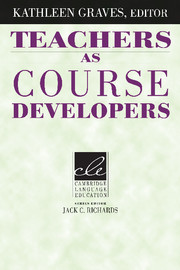Book contents
- Frontmatter
- Contents
- Contributors
- Series editor's preface
- Preface
- Acknowledgments
- 1 Teachers as course developers
- 2 A framework of course development processes
- 3 Designing workplace ESOL courses for Chinese health-care workers at a Boston nursing home
- 4 Designing a seventh-grade social studies course for ESL students at an international school
- 5 Designing an EAP course for postgraduate students in Ecuador
- 6 Designing a writing component for teen courses at a Brazilian language institute
- 7 Planning an advanced listening comprehension elective for Japanese college students
- 8 A curriculum framework for corporate language programs
- Further reading
- Index
5 - Designing an EAP course for postgraduate students in Ecuador
Published online by Cambridge University Press: 18 December 2009
- Frontmatter
- Contents
- Contributors
- Series editor's preface
- Preface
- Acknowledgments
- 1 Teachers as course developers
- 2 A framework of course development processes
- 3 Designing workplace ESOL courses for Chinese health-care workers at a Boston nursing home
- 4 Designing a seventh-grade social studies course for ESL students at an international school
- 5 Designing an EAP course for postgraduate students in Ecuador
- 6 Designing a writing component for teen courses at a Brazilian language institute
- 7 Planning an advanced listening comprehension elective for Japanese college students
- 8 A curriculum framework for corporate language programs
- Further reading
- Index
Summary
Carmen Blyth has taught English as a second and foreign language, developed curricula, and trained teachers in a variety of settings, including Armenia, Egypt, Singapore, and Tanzania. In this chapter, she gives us two avenues into her method of course development. The first is a narrative in the form of journal entries, the second is a series of “mindmaps.” Her extensive experience as a teacher and teacher trainer in both EFL and ESL settings had taught her that drawing up mindmaps was an effective way for her to conceptualize the links in the process and to sort out her thoughts and questions. Blyth's prior experience with English for academic purposes (EAP) courses enabled her to do much of the course design before her arrival in Ecuador.
The course development focus for this chapter is conceptualizing content. Consider the following questions as you read:
Why does Blyth conceptualize content as something that students do?
Why does Blyth list what students will do in class without deciding the order in which they will do what and even without having met the students?
This chapter represents a conversation between a teacher of ESL and herself about the process and the product of course design.
- Type
- Chapter
- Information
- Teachers as Course Developers , pp. 86 - 118Publisher: Cambridge University PressPrint publication year: 1996
- 1
- Cited by

